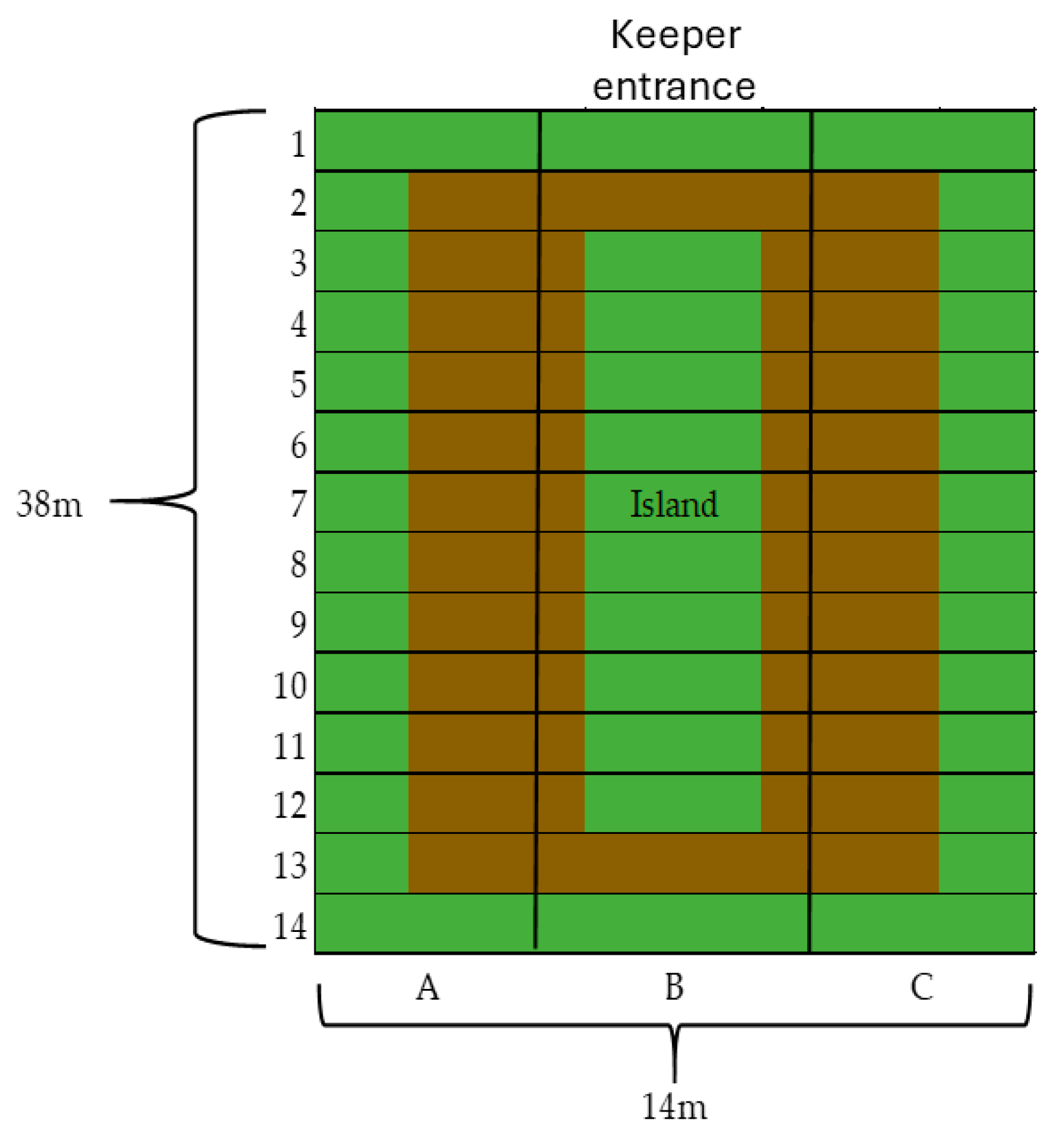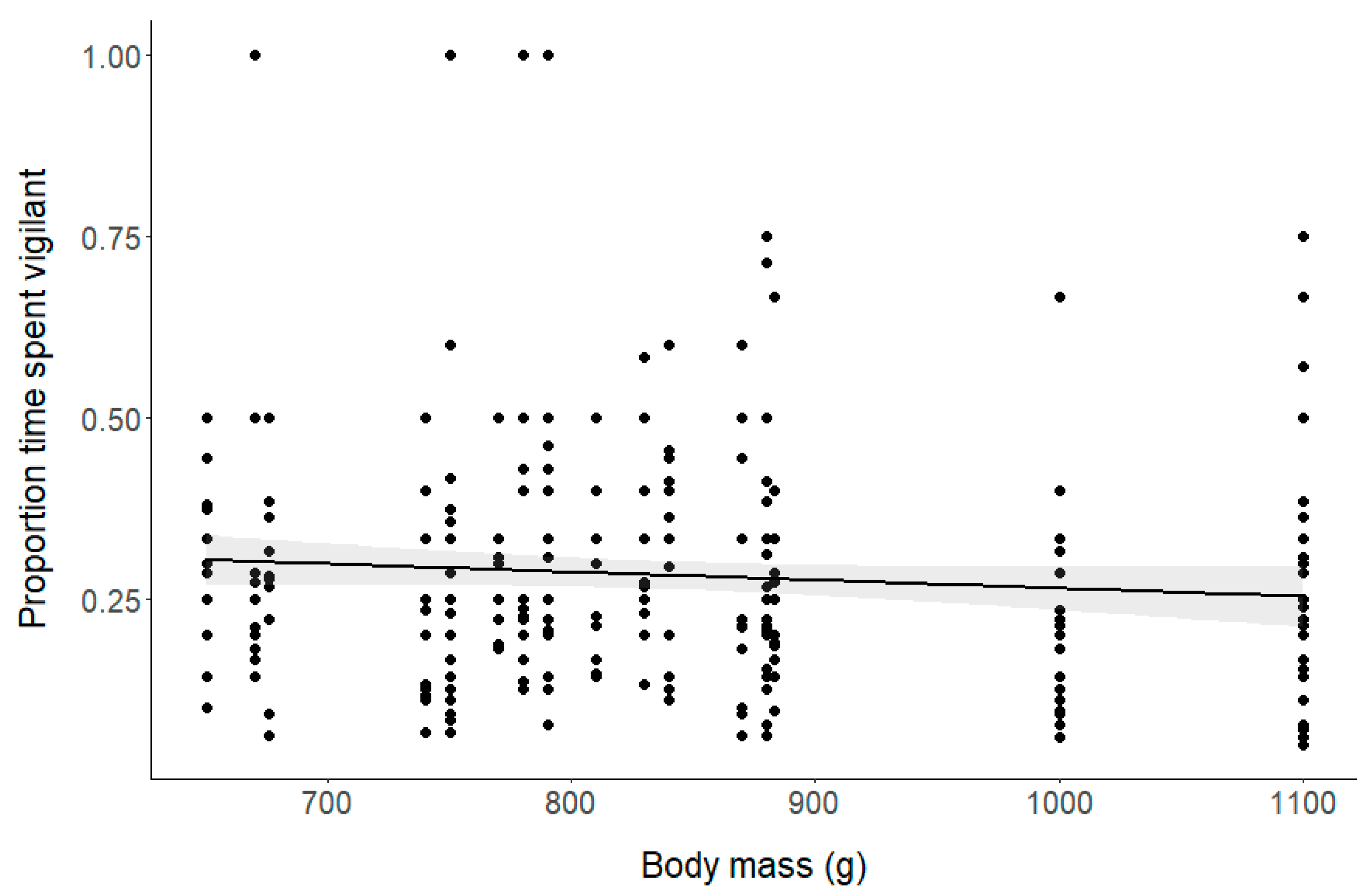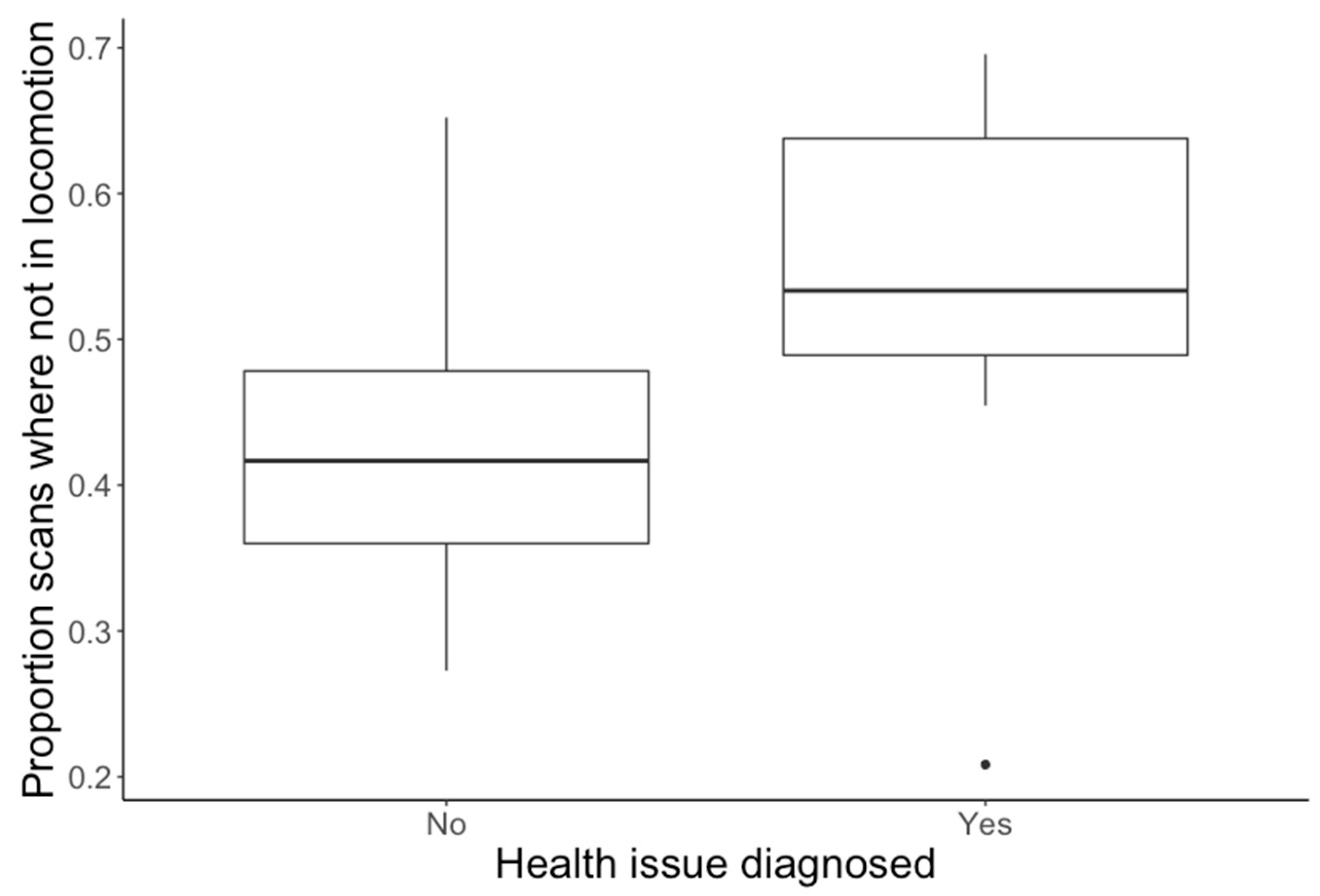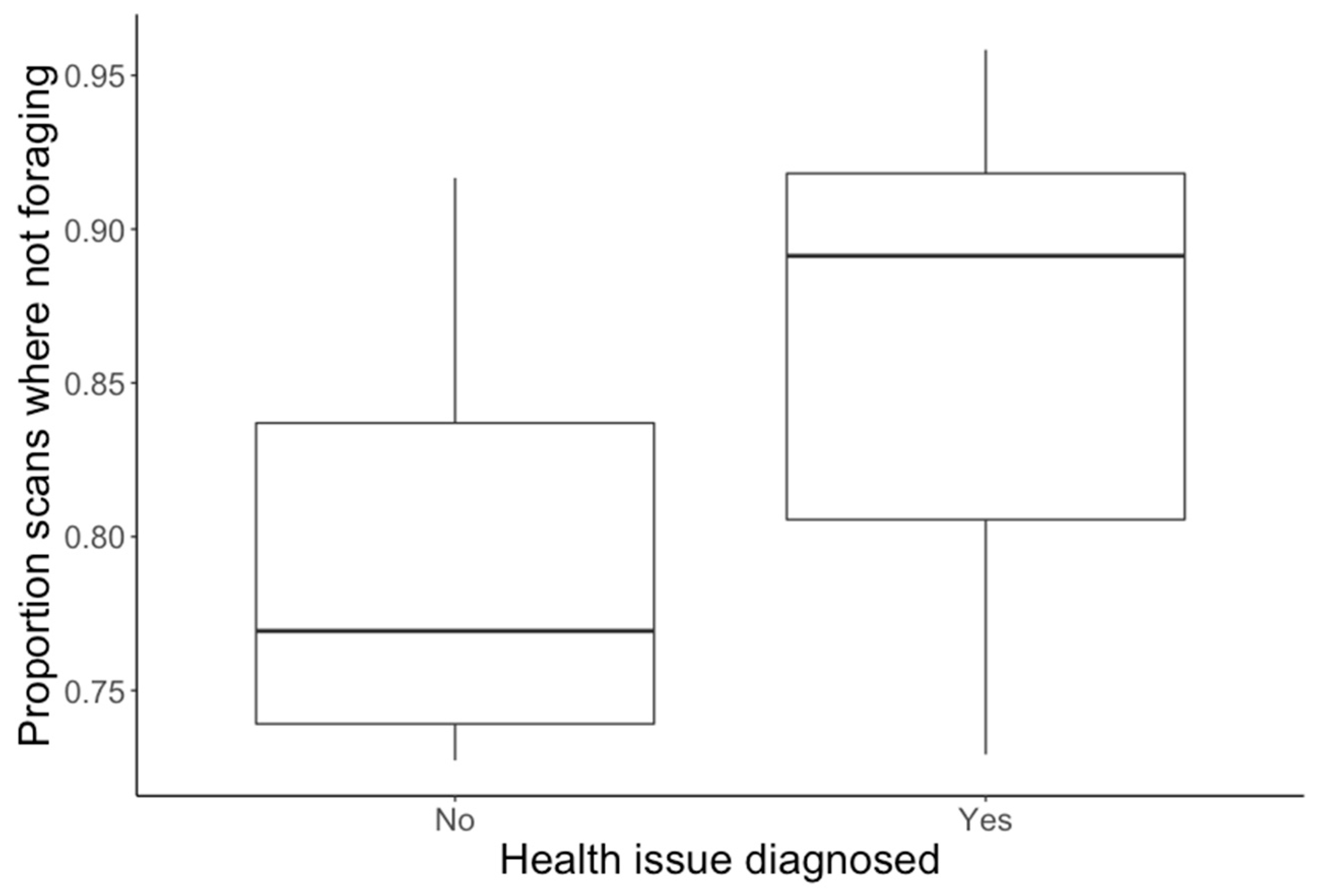In Absentia—Can a Lack of Behaviour Be a Useful Welfare Indicator? An Application to the Captive Management of Livingstone’s Fruit Bats, Pteropus livingstonii
Abstract
1. Introduction
2. Materials and Methods
2.1. Study Population
2.2. Data Collection
2.3. Data Analysis
3. Results
4. Discussion
Supplementary Materials
Author Contributions
Funding
Institutional Review Board Statement
Data Availability Statement
Acknowledgments
Conflicts of Interest
References
- Eguizábal, G.V.; Superina, M.; Palme, R.; Asencio, C.J.; Villarreal, D.P.; Borrelli, L.; Busso, J.M. Non-invasive assessment of the seasonal stress response to veterinary procedures and transportation of zoo-housed Lesser anteater (Tamandua tetradactyla). Animals 2022, 12, 75. [Google Scholar] [CrossRef]
- Rose, P.; Riley, L. The use of Qualitative Behavioural Assessment to zoo welfare measurement and animal husbandry change. J. Zoo Aquar. Res. 2019, 7, 150–161. [Google Scholar]
- Yon, L.; Williams, E.; Harvey, N.D.; Asher, L. Development of a behavioural welfare assessment tool for routine use with captive elephants. PLoS ONE 2019, 14, e0210783. [Google Scholar] [CrossRef]
- Mellor, D.J.; Beausoleil, N.J.; Littlewood, K.E.; McLean, A.N.; McGreevy, P.D.; Jones, B.; Wilkins, C. The 2020 five domains model: Including human–animal interactions in assessments of animal welfare. Animals 2020, 10, 1870. [Google Scholar] [CrossRef] [PubMed]
- Sewall, B.J.; Young, R.; Trewhella, W.J.; Rodríguez-Clark, K.M.; Granek, E.F. Pteropus livingstonii; The IUCN Red List of Threatened Species: Cambridge, UK, 2016; Volume 201. [Google Scholar]
- Daniel, B.M.; Green, K.E.; Doulton, H.; Mohamed Salim, D.; Said, I.; Hudson, M.; Dawson, J.S.; Young, P.R.; Houmadi, A. A bat on the brink? A range-wide survey of the Critically Endangered Livingstone’s fruit bat Pteropus livingstonii. Oryx 2017, 51, 742–751. [Google Scholar] [CrossRef]
- Ibouroi, M.T.; Cheha, A.; Astruc, G.; Dhurham SA, O.; Besnard, A. A habitat suitability analysis at multi-spatial scale of two sympatric flying fox species reveals the urgent need for conservation action. Biodivers. Conserv. 2018, 27, 2395–2423. [Google Scholar] [CrossRef]
- Jones, K.E.; Mickleburgh, S.P.; Sechrest, W.; Walsh, A.L. Global overview of the conservation of island bats: Importance, challenges and opportunities. In Island Bats: Evolution, Ecology & Conservation; University of Chicago Press: Chicago, IL, USA, 2009; pp. 496–531. [Google Scholar]
- Reason, P.F.; Trewhella, W.J. The status of Pteropus livingstonii in the Comores. Oryx 1994, 28, 107–114. [Google Scholar] [CrossRef]
- Wilson, M.W.; Ridlon, A.D.; Gaynor, K.M.; Gaines, S.D.; Stier, A.C.; Halpern, B.S. Ecological impacts of human-induced animal behaviour change. Ecol. Lett. 2020, 23, 1522–1536. [Google Scholar] [CrossRef]
- Bell, E.; Price, E.; Balthes, S.; Cordon, M.; Wormell, D. Flight patterns in zoo-housed fruit bats (Pteropus spp.). Zoo Biol. 2019, 38, 248–257. [Google Scholar] [CrossRef]
- Trewhella, W.J.; Reason, P.F.; Clark, K.M.; Garrett, S.R. The current status of Livingstone’s flying fox (Pteropus livingstonii) in the Federal Islamic Republic (RFI) of the Comores. Phelsuma 1998, 6, 32–40. [Google Scholar]
- Mandl, I.; Houmadi, A.; Said, I.; Abdou BB, A.; Fardane, A.K.; Egger-Peitler, K.; Olesky, R.; Doulton, H.; Chaihane, S.S.A. Using GPS tracking for fruit bat conservation. Oryx 2021, 56, 50–53. [Google Scholar] [CrossRef]
- LeBlanc, D.; Barnard, S. The Captive Environment for Old World Fruit Bats. Bats in Captivity, 2. 2000. Available online: https://www.battag.org/uploads/6/2/7/6/6276216/paper_-_the_captive_environment_for_old_world_fruit_bats.pdf (accessed on 14 May 2024).
- Thorncroft, K.; Wormell, D.; Price, E. Effects of food distribution method on territoriality, activity and access to food in captive Livingstone’s fruit bats (Pteropus livingstonii). Solitaire 2014, 22–26. [Google Scholar]
- Price, E.C.; Roberts, A.; Bennett, L.; Glendewar, G.; Wormell, D. Weight as an indicator of enclosure suitability in Livingstone’s fruit bats (Pteropus livingstonii). Zoo Biol. 2024. [Google Scholar] [CrossRef] [PubMed]
- Segura-Cortijos, C.; Bell, E.; Routh, A.; del Campo, A.M.; Killick, R.; Drane, A.; Barbon, A.R. Mortality and morbidity in captive Livingstone’s fruit bats Pteropus livingstonii. J. Zoo Aquar. Res. 2022, 10, 149–157. [Google Scholar]
- Drane, A.L.; Shave, R.; Routh, A.; Barbon, A. An exploratory investigation of echocardiographic parameters and the effects of posture on cardiac structure and function in the Livingstone’s fruit bat (Pteropus livingstonii). Vet. Radiol. Ultrasound 2018, 59, 89–97. [Google Scholar] [CrossRef] [PubMed]
- Killick, R.; Barbon, A.R.; Barrows, M.; Routh, A.; Saunders, R.; Day, C.; P. G. Cert. Exotic Animal Studies; Naylor, A.; Hayward, N.; Sewell, D.; et al. Medical management of dilated cardiomyopathy in Livingstone fruit bats (Pteropus livingstonii). J. Zoo Wildl. Med. 2017, 48, 1077–1080. [Google Scholar] [CrossRef] [PubMed]
- Welch, M.J.; Smith, T.; Hosie, C.; Wormell, D.; Price, E.; Stanley, C.R. Social Experience of Captive Livingstone’s Fruit Bats (Pteropus livingstonii). Animals 2020, 10, 1321. [Google Scholar] [CrossRef] [PubMed]
- Bateson, M.; Martin, P. Measuring Behaviour: An Introductory Guide, 4th ed.; Cambridge University Press: Cambridge, UK, 2021. [Google Scholar]
- Courts, S.E. General Behaviour and Social Interactions in a Group of Livingstone’s Fruit Bats Pteropus livingstonii at Jersey Wildlife Preservation Trust; Jersey Wildlife Preservation Trust: Jersey, UK, 1996. [Google Scholar]
- R Core Team. R: A Language and Environment for Statistical Computing; R Foundation for Statistical Computing: Vienna, Austria, 2022; Available online: https://www.R-project.org/ (accessed on 14 May 2024).
- Pinheiro, J.C.; Bates, D.M. Approximations to the log-likelihood function in the nonlinear mixed-effects model. J. Comput. Graph. Stat. 1995, 4, 12–35. [Google Scholar] [CrossRef]
- Rizopoulos, D. GLMMadaptive: Generalized Linear Mixed Models Using Adaptive Gaussian Quadrature; R Package Version 05–1; GitHub: San Francisco, CA, USA, 2019. [Google Scholar]
- Akaike, H. A new look at the statistical model identification. IEEE Trans. Autom. Control 1974, 19, 716–723. [Google Scholar] [CrossRef]
- Burnham, K.P.; Anderson, D.R. Multimodel inference: Understanding AIC and BIC in model selection. Sociol. Methods Res. 2004, 33, 261–304. [Google Scholar] [CrossRef]
- Richdon, S.; Price, E.; Wormell, D.; Jones, G.; McCabe, G. Predictors of dominance rank and agonistic interactions in captive Livingstone’s fruit bats. Curr. Zool. 2022, 69, 694–702. [Google Scholar] [CrossRef] [PubMed]
- O’Connor, K. Mealworm Dispensers as Environmental Enrichment for Captive Rodrigues Fruit Bats (Pteropus rodricensis). Anim. Welf. 2000, 9, 123–137. [Google Scholar] [CrossRef]
- Edwards, M.J.; Stanley, C.R.; Hosie, C.A.; Richdon, S.; Price, E.; Wormell, D.; Smith, T.E. Social roles influence cortisol levels in captive Livingstone’s fruit bats (Pteropus livingstonii). Horm. Behav. 2022, 144, 105228. [Google Scholar] [CrossRef] [PubMed]
- Smith, S.J.; Leslie, D.M. Pteropus livingstonii. Mamm. Species 2006, 792, 1–5. [Google Scholar] [CrossRef] [PubMed]





| Behavioural Category | Sub-Category | Description |
|---|---|---|
| Vigilant | Bipedal hang | Hanging by both hindlimbs, with wings either wrapped around the ventral region or folded on either side of the body. Eyes are open, and there may be ear movement, air sniffing, and head movement. |
| Quadrupedal hang | As bipedal, but hanging by all four limbs, wings folded on either side of the body. | |
| Foraging | Drink | Using the tongue to ingest water from a water dish or to lick moisture off the walls. |
| Feed | Ingestion of food items. Larger pieces of hard food items may be held by a hindlimb whilst licking or biting at food. | |
| Investigate | Sniffing food items with the nose or sniffing within 30 cm of them. | |
| Locomotion | Climb | Movement from one area of the substrate not directly connected to another, accomplished by the use of both forelimbs to hook onto the substrate. |
| Flight | The flapping of both wings to achieve horizontal movement through the air. | |
| Mesh movement | Forward movement on a horizontal mesh, using fore and hindlimbs. The forelimb is followed by the opposing hindlimb, followed by the opposite forelimb, etc. | |
| Floor movement | A slow crawl, using opposite fore and hindlimbs in succession, along the ground. | |
| Roosting | Roost alone | Hanging by a single hindlimb, wings wrapped around the ventral region, and muzzle tucked into the chest. Eyes are closed; no ear movement. |
| Roost in pairs | As roost alone, but with one bat wrapped in the other’s wings. |
| Behaviour | Intercept | Body Mass | Health Issue | Period | |
|---|---|---|---|---|---|
| Vigilance (duration) Vigilance (binary) | −0.755 ± 0.251 | −0.008 ± 0.000 | 0.064 ± 0.037 | −0.066 ± 0.074 | |
| 0.114 ± 0.759 | 0.000 ± 0.001 | −0.092 ± 0.112 | −0.499 ± 0.204 | ||
| Locomotion (duration) Locomotion (binary) | −1.459 ± 0.089 | - | −0.068 ± 0.051 | 0.006 ± 0.088 | |
| 0.162 ± 0.182 | - | 0.267 ± 0.097 | −0.644 ± 0.205 | ||
| Roosting (duration) Roosting (binary) | −0.341 ± 0.332 | 0.000 ± 0.000 | - | −0.282 ± 0.101 | |
| −2.440 ± 0.767 | 0.002 ± 0.001 | - | 0.448 ± 0.225 | ||
| Foraging (duration) Foraging (binary) | −1.643 ± 0.930 | 0.000 ± 0.000 | 0.126 ± 0.189 | - | |
| 4.321 ± 1.112 | −0.004 ± 0.001 | 0.739 ± 0.252 | - | ||
Disclaimer/Publisher’s Note: The statements, opinions and data contained in all publications are solely those of the individual author(s) and contributor(s) and not of MDPI and/or the editor(s). MDPI and/or the editor(s) disclaim responsibility for any injury to people or property resulting from any ideas, methods, instructions or products referred to in the content. |
© 2024 by the authors. Licensee MDPI, Basel, Switzerland. This article is an open access article distributed under the terms and conditions of the Creative Commons Attribution (CC BY) license (https://creativecommons.org/licenses/by/4.0/).
Share and Cite
Edwards, M.J.; Hosie, C.A.; Naidenov, L.; Price, E.; Smith, T.E.; Wormell, D.; Stanley, C.R. In Absentia—Can a Lack of Behaviour Be a Useful Welfare Indicator? An Application to the Captive Management of Livingstone’s Fruit Bats, Pteropus livingstonii. J. Zool. Bot. Gard. 2024, 5, 226-237. https://doi.org/10.3390/jzbg5020016
Edwards MJ, Hosie CA, Naidenov L, Price E, Smith TE, Wormell D, Stanley CR. In Absentia—Can a Lack of Behaviour Be a Useful Welfare Indicator? An Application to the Captive Management of Livingstone’s Fruit Bats, Pteropus livingstonii. Journal of Zoological and Botanical Gardens. 2024; 5(2):226-237. https://doi.org/10.3390/jzbg5020016
Chicago/Turabian StyleEdwards, Morgan J., Charlotte A. Hosie, Laura Naidenov, Eluned Price, Tessa E. Smith, Dominic Wormell, and Christina R. Stanley. 2024. "In Absentia—Can a Lack of Behaviour Be a Useful Welfare Indicator? An Application to the Captive Management of Livingstone’s Fruit Bats, Pteropus livingstonii" Journal of Zoological and Botanical Gardens 5, no. 2: 226-237. https://doi.org/10.3390/jzbg5020016
APA StyleEdwards, M. J., Hosie, C. A., Naidenov, L., Price, E., Smith, T. E., Wormell, D., & Stanley, C. R. (2024). In Absentia—Can a Lack of Behaviour Be a Useful Welfare Indicator? An Application to the Captive Management of Livingstone’s Fruit Bats, Pteropus livingstonii. Journal of Zoological and Botanical Gardens, 5(2), 226-237. https://doi.org/10.3390/jzbg5020016






